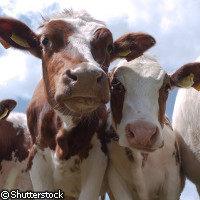Researchers link food choices with lower greenhouse gas emissions
Non-CO2 greenhouse gases (GHG) from agriculture could be reduced by 84% by 2055 if consumption of animal products is reduced and agricultural practices are improved, say researchers from the Potsdam Institute for Climate Impact Research (PIK). Their modelling study has been published in the journal Global Environmental Change. Approximately 15% of global man-made non-CO2 emissions come from the agricultural sector. Methane and nitrous oxide are produced when synthetic fertilisers are applied on cropland, for instance. This problem is multiplied by the fact that livestock require large amounts of fodder, which of course are grown with more fertiliser. In addition, the animals themselves produce more emissions during the food's digestion and excretion. The PIK researchers combined socioeconomic information on population, income, food demand and production costs with environmental data on potential crop yields in a global land-use model. They found that emissions will rise considerably over the next 45 years if food consumption and agricultural patterns remain as they were in 1995 - the year of reference for this study. Should even more meat and dairy products be consumed, emissions too will increase. If consumers reduced their meat intake, however, emissions could be cut by 25% per decade. 'Meat and milk really matter,' says PIK's Dr Alexander Popp, lead author of the study. 'Reduced consumption could decrease the future emissions of nitrous oxide and methane from agriculture to levels below those of 1995.' 'Besides the conscious choice of food on the consumers' side there are technical mitigation options on the producers' side to reduce emissions significantly, he adds. Such technical mitigation options include better water, manure and herd management as well as more efficient fertilisers. In addition, better breeding and feeding practices could enhance the quality of livestock and hence do their part in reducing methane and nitrous oxide emissions. Yet, a combination of both - a change from a meat-heavy diet to one with less milk and meat and technical improvements - turns out to be the most effective way to bring down emissions. 'For both technical and behavioural GHG reduction options, incentives are needed to guarantee that the agricultural sector contributes its share to climate change mitigation,' the PIK researchers point out. 'Putting a price on GHG emissions via a tax or emission trading scheme is an economically sound prescription for addressing the negative externalities of greenhouse gases. 'On the one hand, a price on non-CO2 GHG emissions from the agricultural sector will lead to less application of GHG-intensive practices and will set an incentive for developing new technologies and implementing existing ones,' they add. 'On the other hand, as it seems very unlikely that behavioural changes will happen voluntarily, GHG pricing or regulation will also modify consumer prices and therefore affect changes in consumption patterns.'
Countries
Austria, Germany, Greece, Saudi Arabia

